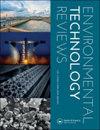Biosorption of heavy metals from water: mechanism, critical evaluation and translatability of methodology
Q1 Environmental Science
引用次数: 4
Abstract
ABSTRACT The presence of heavy metals in drinking water is a serious global issue. Sustainable methods for treating drinking water such as biosorption are gaining popularity. The maximum permissible limits of most metal ions in drinking water are in the range from 0.003 to 2 mgL−1, however, the elevated concentrations in the range 0.01–2.5 mgL−1 are reported in contaminated waters in various regions of the world. Therefore, selecting the initial metal ion concentration range, and an optimum pH suitable for treating drinking water (pH 6.5–8.5) for laboratory experiments is a challenge for multi-ion biosorption studies. For the quantification of metal ions, ICP-MS is often used owing to its many advantages, however, the high operational costs of this instrument limits its use in research laboratories. Surface characterisation techniques such as TEM, NMR, ESR and related techniques are often ignored in biosorption studies although, these give valuable information pertaining to the mechanism of biosorption. Many theoretical models for explaining the biosorption mechanism have been proposed in the literature, one often contradicting the other. One of the major drawbacks of published biosorption studies is that too much emphasis has been laid on the theoretical explanation of biosorption mechanism and too little has been done to address the lack of practical application in terms of translatability of the methodology for commercial use. The present review highlights such issues while giving an insight on the processes, parameters and models used in biosorption reactions. GRAPHICAL ABSTRACT重金属在水中的生物吸附:机理、关键评价和方法的可译性
饮用水中重金属的存在是一个严重的全球性问题。生物吸附等可持续处理饮用水的方法越来越受欢迎。饮用水中大多数金属离子的最大允许限度在0.003至2 mg / l−1之间,然而,据报道,在世界各地区受污染的水中,金属离子浓度在0.01至2.5 mg / l−1之间升高。因此,选择适合处理饮用水的初始金属离子浓度范围和实验室实验的最佳pH值(pH 6.5-8.5)是多离子生物吸附研究的一个挑战。对于金属离子的定量,ICP-MS由于其许多优点而经常被使用,然而,该仪器的高操作成本限制了其在研究实验室的使用。表面表征技术,如TEM, NMR, ESR和相关技术在生物吸附研究中经常被忽视,尽管这些技术提供了有关生物吸附机制的有价值的信息。文献中提出了许多解释生物吸附机理的理论模型,其中一个经常相互矛盾。已发表的生物吸附研究的主要缺点之一是过于强调生物吸附机理的理论解释,而在商业用途的方法可翻译性方面缺乏实际应用。目前的审查突出了这些问题,同时给出了在生物吸附反应中使用的过程,参数和模型的见解。图形抽象
本文章由计算机程序翻译,如有差异,请以英文原文为准。
求助全文
约1分钟内获得全文
求助全文
来源期刊

Environmental Technology Reviews
Environmental Science-Water Science and Technology
CiteScore
6.90
自引率
0.00%
发文量
8
 求助内容:
求助内容: 应助结果提醒方式:
应助结果提醒方式:


